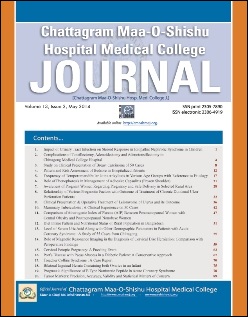Frequency of Temporomandibular Joint Ankylosis in Various Age Groups with Reference to Etiology
DOI:
https://doi.org/10.3329/cmoshmcj.v13i2.21056Keywords:
Temporomandibular joint, ankylosis, traumaAbstract
Introduction: Temporomandibular joint ankylosis is a gradually developing condition manifested by mandibular hypomobility. Limitation of mouth opening can be caused by bony or fibrous ankylosis of the temporomandibular joint as sequel to trauma, infection, and autoimmune diseases. The purpose of this study was to determine the frequency of temporomandibular joint ankylosis in various age groups and to see the etiology of temporomandibular joint ankylosis.
Materials & methods: This descriptive study study was carried out at the department of Oral and Maxillofacial surgery, deMontmorency College of Dentistry / Punjab Dental Hospital, Lahore from September 2004 to August 2005 prospectively. A total 60 patients of various ages having TMJ ankylosis were included. Patients presented with TMJ ankylosis were assessed with detailed history and physical examination. Basic investigations including conventional radiographs and orthopentomogram were undertaken for every patient.
Results: Females predominate with 35 (58.30%). Age ranged from 4 to 36 years and 11-20 years (60%) group predominating. In unilateral cases, left side involvement was more common in both males and females. TMJ ankylosis was post traumatic in 47(78.3%) cases followed by infection 7(11.7%) while birth trauma 2(3.3%) was rare. RTA was seen to the most frequent etiological factor followed by the fall.
Conclusions: Temporomandibular joint ankylosis is a preventive entity if posttraumatic rehabilitation is instituted early and properly.
Downloads
350
455
Downloads
Published
How to Cite
Issue
Section
License
Authors of articles published in CMOSHMC Journal retain the copyright of their articles and are free to reproduce and disseminate their work.
A Copyright and License Agreement -signed and dated by the corresponding author on behalf of all authors -must be submitted with each manuscript submission.

